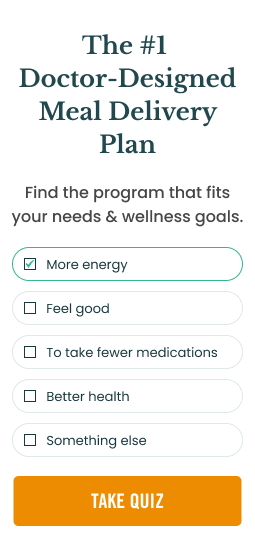
When you’re trying to eat healthy, it can feel frustrating when a meal leaves you less than satisfied.
Research suggests this can happen for various reasons, and understanding these potential causes may help you identify what’s making the most significant impact. If you wonder, “Why do I not feel full after eating?” a few key strategies can make all the difference.
Read on to discover answers to common questions about fullness and satiety. Plus, find tips and tricks for crafting truly filling meals.
What Does Satiation Mean?
Typically, the word satiation is used to describe a feeling of fullness. Although satiation and satiety may sound like synonyms and are often used interchangeably, there’s a subtle difference between the two words. Satiety technically means feeling full between meals, while satiation is feeling fullness you experience while eating.
Research suggests that the feeling of satiation may mainly rely on the stomach's reaction—sometimes called gastric accommodation. At the same time, satiety involves a more complex interplay of signals between the gut (intestines) and the brain. These signals include hunger hormones like ghrelin and leptin, influencing the desire to eat and regulating hunger and satiety. Blood sugar and insulin also impact appetite and can affect the signals sent to the brain.
In other words, a lot goes into hunger, satiation, and satiety! People are often more familiar with what hunger and satiety feel like, but are less familiar with satiation (that increasing feeling of fullness during a meal)—it’s easy to miss if you’re distracted.
Luckily, tapping into how you’re feeling during a meal can help you better listen to your body, not to mention it may also go a long way for appetite control, weight management, and overall health.
Common Reasons for Not Feeling Full After Eating
Are you curious about why you don’t feel satisfied after eating? Here are a couple of common causes that may be the culprit.
Food Choices
Interestingly, different foods have different effects on the body. Carbohydrates are often utilized quickly, while proteins, healthy fats, and fiber are digested slower. Sometimes, your meal may have lacked these longer-lasting nutrients if you don’t feel full during or after eating.
Adding proteins, fiber, and healthy fats to each meal can keep you feeling full for longer. As a bonus, these nutrients also help balance blood sugar.
Not Eating Enough
Although it may sound like a no-brainer, it’s worth saying—if you’re still feeling less-than-satiated after a meal, it may be because you aren’t eating enough. If your nutrient, calorie, or food intake is falling below the recommended levels for your age, gender, weight, and activity level, you may be more likely to feel hungry even after you’ve eaten.
How can you tell if this is the case? If you’re not trying to lose weight but are experiencing weight loss, that may be a sign that you’re not eating enough. You can use an online calorie calculator to estimate your needs or consult with a registered dietitian to understand your unique requirements better.
Eating Too Quickly
Even though brain signals are relatively speedy, they still need time to catch up to what’s happening in the body. It’s estimated to take about 20 to 30 minutes for the brain to get the message that the body is feeling full. Eating foods too fast may not give the brain enough time to catch up and may ultimately lead to mismatched satiety signals.
For example, eating in under 20 minutes may mean clearing the dinner table when you realize you aren’t full. Alternatively, you may overeat in a short period, and end up feeling uncomfortably full by the time the brain catches up to the body. In any case, eating too fast isn’t ideal.
Distracted or Emotional Eating
Yet another reason you may struggle to feel full during or after eating is distracted eating. As mentioned above, if you’re distracted while eating, such as by scrolling through social media or watching television, it can be easy to miss the signs of satiation.
Ultimately, this can contribute to unintentional overeating, which can lead to weight gain and may also make you feel out of touch with your body.
Emotional eating may also affect how full you feel after a meal. During times of stress or anxiety, the practice of eating can become a distraction in itself.
Eating quickly or overeating may also become a reliable coping mechanism for releasing feel-good chemicals in the body. Unfortunately, as with distracted eating, this style may override the body’s natural satiety signals, making it difficult to recognize one’s body’s needs.
Underlying Health Conditions
If you’ve explored the above reasons and still struggle to feel full after a meal, it may be time to look into underlying health conditions. A hormone imbalance may be to blame, mainly if it affects hunger hormones, insulin sensitivity, or blood sugar balance. For instance, individuals dealing with diabetes or polycystic ovary syndrome (PCOS) may struggle to make sense of appetite, hunger, or fullness signals due to changes in the body’s metabolism.
Since hunger and satiety involve the brain, brain injuries or mental health disorders can also be a factor. For example, eating disorders or restricted eating can not only deprive the brain of needed nutrients but may also blunt satiety signals when eating feels like a fearful behavior. Fortunately, it is possible to “rewire” neural pathways and learn to appreciate food and the feeling of satiety again.
Research is still in preliminary stages, but scientists say gut health may also affect satiety. A healthy microbiome or intestinal environment, including “good” bacteria, may promote healthy satiety signals. On the other hand, less-than-optimal gut health may have implications for feelings of fullness.
How to Feel Full and Satisfied
As with many diet principles, the secret to feeling satiated is a matter of balance. Balanced meals can help you feel nourished and satisfied as you go about your day as part of a balanced lifestyle.
Learning to embrace satiation during meals and satiety between meals can be an integral part of your health and wellness journey, and mindful eating techniques (like those listed below) can help you get closer to your goals.
Eat to Feel Full
Speaking of goals, it’s essential to eat to feel full. This concept may sound obvious, but a recent study suggests some people eat to avoid hunger rather than feel full. This study also found that the ultimate goal—feeling full or avoiding hunger—predicted portion size was selected.
In other words, mindset matters as you approach the plate. Heading into a meal to feel comfortable or full can help you better define your needs during your eating experience. It also allows you to select a more appropriate amount of food to meet your needs, resulting in a higher likelihood of satiation.
Build A Balanced Plate
Sugar may satisfy you for a moment, but the resulting sugar “spike” and “crash” aren’t worth it. To promote satiety, eat a nutrient-dense meal. Protein-rich foods and foods high in fiber increase satiety without risking the sugar rollercoaster. Use nutrient-rich foods to create a well-balanced plate, such as one that looks like the MyPlate guide.
Some studies suggest texture may play a role in fullness and that eating whole foods instead of liquid meals may help reduce hunger. Eating more whole foods on a plate rather than more liquid meals, like meal replacements in a bottle, could increase satiety. Yet another reason to aim for balanced meals!
Homemade meals can also help prime your tastebuds for satiation by influencing your level of anticipation. Aromas created by cooking can excite your brain and body for the meal that’s on the way.
Don’t worry—you can still experience this effect with meal delivery options like bistroMD. Even though bistroMD’s balanced meals are ready to eat in 5 minutes or less, you can spend that short wait engaging your senses and eagerly awaiting your sure-to-satiate meal.
Make Eating Mindful
With plenty of distractions, putting devices away and enjoying a meal can be difficult. However, doing so can help you experience more mindful eating, so you can better listen to your body.
Putting away as many distractions as possible will allow you to appreciate all the different aspects of your food, from mouthfeel to appearance. It can also help you connect with your body’s natural hunger and fullness cues.
One easy way to eat more mindfully is by slowing down and chewing your food. Some experts suggest chewing one bite as many as 20 times! This may sound like a lot at first, but chewing can help you break your food down to a more manageable level for the body. As mentioned above, slowing down the eating process gives your brain enough time to register that the body is feeling full.
Researchers are so keen on this idea that they’ve been testing a smart fork that vibrates to alert you if you’re eating too quickly. Until these utensils are universally available, you’ll have to develop the skill of eating slowly and mindfully for yourself.
Stay Hydrated
It may sound like a wives’ tale, but there’s some truth to drinking water when you’re feeling hungry. Water is considered a natural appetite suppressant since it takes up some room in the stomach.
Though you won’t get the same feeling of fullness from drinking a glass of water that you’ll get from a balanced meal, staying hydrated throughout the day may help keep you from feeling excessively thirsty or hungry.
How Do You Feel Full? A Satisfying Ending
Don't beat yourself up if you’re not feeling full after meals! A complex set of interactions between the body and brain governs satiation, and it may take relearning some of your body’s natural signals to tap into satiety.
Understanding possible causes, like eating too quickly or an underlying health condition, can help you identify problem areas and make necessary changes. Eating protein, fiber, and nutrient-rich meals can contribute to satiety, as can introducing more mindful eating habits into your routine.






